Congo Safaris
Congo Safaris : Though it is not popular like other East Africa destinations, Congo formerly known as Zaire is one of the amazing destinations to visit on an African safari.
Congo as a country has a great tourism potential with some of the most beautiful parks in the world teeming with a large variety flora and fauna species. Democratic Republic of Congo is one of the best places in Africa to see wildlife including the rare endangered mountain gorillas and eastern lowland gorillas as well as the elusive Okapi among others.
Democratic Republic of Congo is situated close to the Equator, however the climate is rated mild categorized as tropical highland climate with temperatures usually between pleasant 19℃ and 25℃. This tropical climate is characterized by heavy precipitation and high temperatures and humidity.
The country is crossed by the Equator just north of Lirangem in the north a dry season extending from November through March and a rainy season from April through October. Whereas in the south the reverse is true, on the both sides of the Equator, the local climate exist with two dry and two wet seasons. The annual precipitation is abundant throughout the country, but seasonal and region variations are important. Precipitation averages more than 48 inches (1,200 mm) annual but often surpasses 80 inches (2,000 m).
Briefs about congo
The Democratic Republic of Congo (DRC) formerly known as Zaire or Congo Kinshasha is arguably Africa’s second largest country after Algeria. It is located in Central Africa and borders Uganda, Rwanda, Burundi and Tanzania to the east, South Sudan and Central African Republic to the North, Angola and Zambia to the south, Republic of Congo to the South and the Atlantic Ocean in the south west.
The Democratic Republic of Congo (DRC) also formerly known as Congo Zaire, Congo Kinshasa is arguably Africa’s second largest country after Algeria. It is located in central Africa and borders Uganda, Rwanda, Burundi and Tanzania to the east, South Sudan and Central African Republic to the North, Angola and Zambia to the south, Republic of Congo to the south and the Atlantic Ocean in the south west.
The History of the Congo
Prior to the colonization of Congo, the country is believed to have been occupied by the Bantu as early as the 7th Century. This accelerated during the transition from Stone Ageto Iron Age that so many migrate to Central Africa in search of arable land. Today, Congo is second to none as the world’s most populated francophone nation but also fourth most populated country in the world. Like any other Africa nation, DRC was also greatly affected by the salve trade mainly by Arab – Swahili traders.
DR.Congo was colonized on 17th November 1879 by King Leopold II of Belgium. The King had sponsored exploration and administrative ventures of Sir Henry Morton Stanley. Following the Berlin Conference of 1885 that led to the scramble and partition of Africa, King Leopold acquired Congo as his private land and maned it the Congo Free State. Infrastructure developments were quickly initiated in the state that include construction of a railway line from the coast to Leopoldville that is today known as Kinshasa
The climate of Congo is influenced by the Congo Rain Forest, the largest rainforest in the wild that is only second to the Amazon. The extensive blossoming jungle is encompassed by the Congo basin that drain it waters in the Atlantic Ocean. The rain forest is surrounded by plateaus with savannah in the southern region and northern region, the highland areas in the west and glaciated mountains in the east on the border with Uganda. The Congo River basin covers an area of 1,000,000 square kilometers with major tributaries like Lulonga, Ruzizi, Kasai, Ubangi and Sangha.
Also, Democratic Republic of Congo hosts the world’s few remaining active volcanoes that is Mt. Nyirangongo and Mt. Nyamulagira which are notable attractions in the country. Mount Nyirangongo last erputted in 2002 with lava flowing to the nearby Goma City damaging the town and poisoning the Lake Kivu water.
The Climate of D.R Congo
The area of the Democratic Republic of Congo spans over the Equator with a third in the Northern hemisphere and rest in the South. As another state in the equatorial region, it experiences warm climate with rainfall averages of 2000mm a year. The nation has basically two seasons that are dry and wet season, these influence the economic activity of agriculture in the nation and also experiences high humidity levels and the highest number of thunderstorms.
The History of the Congo
Prior to the colonization of Congo, the country is believed to have been occupied by the Bantu as early as the 7th Century. This accelerated during the transition from Stone Ageto Iron Age that so many migrate to Central Africa in search of arable land. Today, Congo is second to none as the world’s most populated francophone nation but also fourth most populated country in the world. Like any other Africa nation, DRC was also greatly affected by the salve trade mainly by Arab – Swahili traders.
DR.Congo was colonized on 17th November 1879 by King Leopold II of Belgium. The King had sponsored exploration and administrative ventures of Sir Henry Morton Stanley. Following the Berlin Conference of 1885 that led to the scramble and partition of Africa, King Leopold acquired Congo as his private land and maned it the Congo Free State. Infrastructure developments were quickly initiated in the state that include construction of a railway line from the coast to Leopoldville that is today known as Kinshasa
Where to go for a safari in Congo
Virunga National Park
Virunga National Park is the most famous attraction as well as safari destination in Congo, the park is also a great paradise for wildlife enthusiasts and a famous destination for gorilla trekking tours.
Virunga National Park is one of the few destinations in the world hosting the endangered mountain gorillas and is an incredible place to see gorillas in their natural habitat, the park is part of the Great Virunga Conservation Area spanning along the Virunga Mountains in Uganda, Rwanda as well as Congo.
Congo is home to one of the population of mountain gorillas in the world.
Virunga National Park is located in the center of the Albertine Rift, between Uganda and Rwanda covering an area of 7,800 kilometers stretching from the Virunga Massif in the South, to the Rwenzori Mountains in the North. The park is renowned UNESCO World Heritage Site recognized for its exceptional wildlife and habitats, the park has 8 habituated gorilla families and two families in the process of being habituated. This makes it a great place for gorilla trekking.
Habituated gorilla families in Virunga National Park include
- Kabirizi Gorilla Family
- Bageni Gorilla Family
- Mapuwa Gorilla Family
- Rugendo Gorilla Family
- Lulengo Gorilla Family
- Munyaga Gorilla Family
- Humba Gorilla Family
- Nyakamwe Gorilla Family
Virunga National Park is an unmissable destination for gorilla trekking adventures in Africa.
In addition to Mountain Gorillas, Virunga National Park is home to 196 species of mammals, 67 amphibians, 708 bird species and 108 reptile species. Some of the animals include Aardvark, African Buffalos, African Bush Elephants, African Leopards, Bay Duikers, the Blue Duiker, Boehm’s Bush Squirrel, Bongo, Bushbuck, Checkered Elephant, Crested Porcupine, Emin’s Pouched Rat, Giant Forest Hog, Giant Pangolin, Lord Derby’s Scaly tailed Squirrel, Marsh Mongoose, Okapi, Red River Hog, Tree Pangolin, Water Chevrotain and Western Tree Hyrax among others. Primates include Chimpanzees, Blue Monkeys, Central African Red Colobus, De Brazza’s Monkey, Dent’s Mona Monkeys, Golden Monkeys, Grey Cheeked Mangabey, Hamlyn’s Monkeys, Mantled Guereza and Olive Baboon among others,
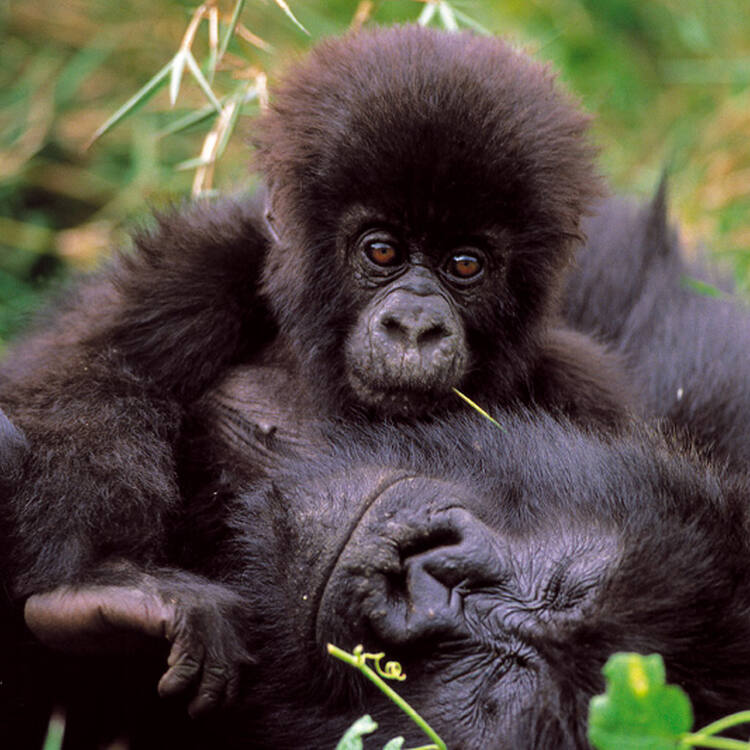
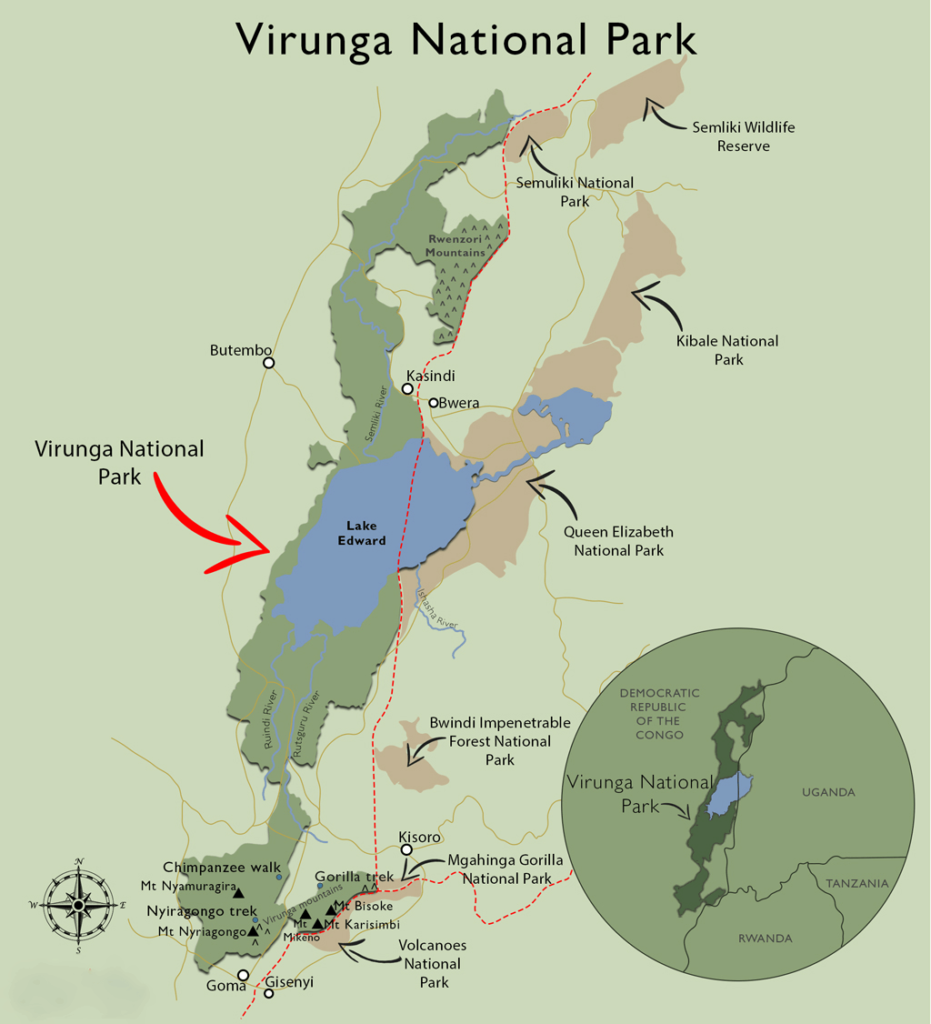

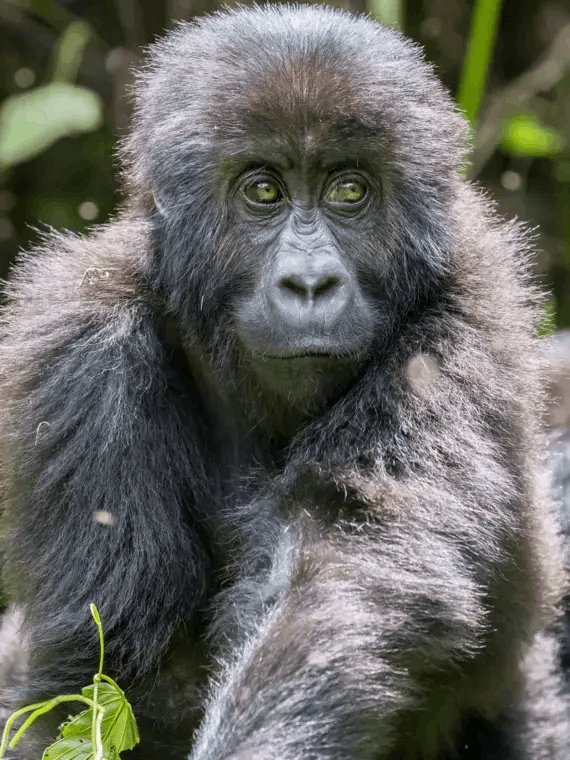
Kahuzi Biega National Park
Kahuzi Biega National Park is a hidden gem of Democratic Republic of Congo situated near the border between Rwanda and the Demcoratic Republic of Congo next to Lake Kivu in the town of Bukavu. The park covers approximately 6,000 square kilometers consisting of lowland terrain and mountains.
Kahuzi Biega is one of the largest national parks in Congo established in 1970 by the Belgin Wildlife Conservationist and photographer Adrien Deschryver, the park is one of the only two places to see the Eastern lowland gorillas and the second one is Salonga National Park in Centra Africa.
In addition to the low land gorillas, Kahuzi Biega boasts breathtaking landscape comprising lush green forests and dormant volcanoes.
Mount Nyirangongo
Mount Nyirangongo is an active volcano found within the Virunga National Park, the volcano is among the active volcanoes in Africa standing 3,470 meters high capped with the world’s largest crater lake. Since 1882, this volcano has erupted about 34 times and the most recent eruption was on May 2021.
Climbing Mount Nyirangongo is one of the amazing Congo safari activities to do taking about 5-6 hours, usually hikers spend the night at the accommodation set around the rim of the lave lake. A successful hike to the summit of Nyirangongo Volcano offers you wonderful views of the lava lake and the surrounding Community.
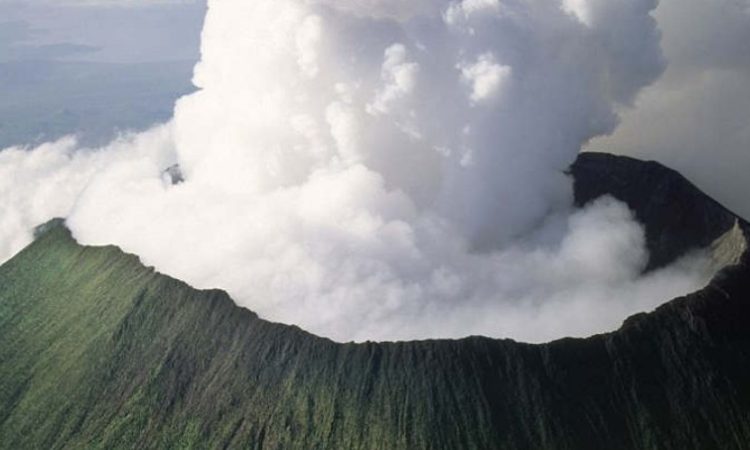
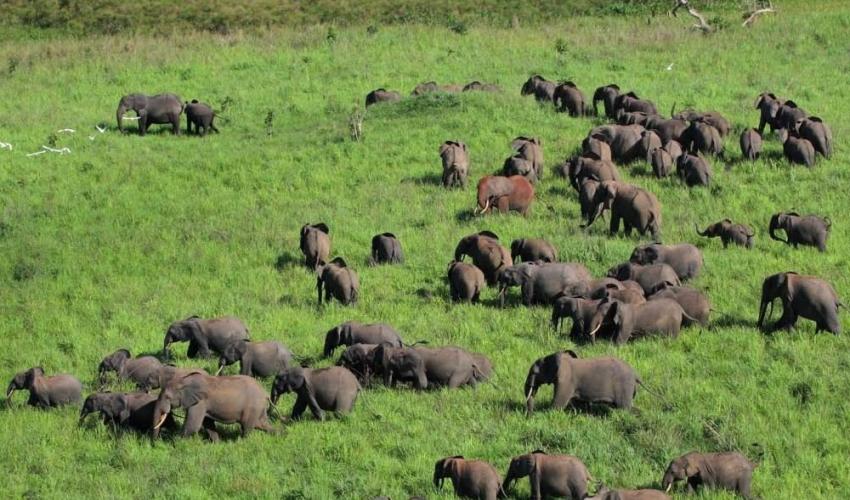
Garamba National Park
Garamba National Park is a less visited park in Congo, it is one of the Africa’s great national parks and a UNESCO World Heritage Site. While on a Congo Safari in this park, expect stunning views of unending African savannah and grasslands.
Garamba National Park is home to array of wildlife species including giraffes, hippos, rhinoceros, antelopes and several bird species. Unfortunately the population of wildlife in this park is threatened by massive poaching.
Caution should be taken while visiting the park on a safari as rebels and armed groups from the neighboring countries have sometimes taken refuge in the deeper areas of the park.
Salonga National Park
Salonga National Park is the largest rainforest in Africa and is one of the many UNESCO World Heritage sites in Congo, the sheer amount and variety of fauna and flora makes visiting this beautiful park a must.
The park is home to a number of habituated bonobo groups, elephants, buffaloes, leopards among others.
Lola Ya Bonobo Sanctuary
Lola Ya Bonobo Sanctuary is a sanctuary to the endangered bonobo species, the closest relatives of human and offers a chance to see and interact with theme. The Bonobos are endangered pygmy chimpanzees that are only found in the DR.Congo.
The Bonobos are relatively peaceful primates compared to their large cousins, but they have faced great persecution and are hunted for their meat.
The Sanctuary covers a forest area of about 3- hectares and helps in protecting youngsters left orphaned after the killing of adults. Staff and volunteers at the sanctuary feed them and protect them from being sold as pets in illegal markets.
Congo Safari Packages
A Congo Safari transcends the conventional travel experience, elevating it to a realm of untouched wilderness. It is an ode to nature’s beauty and a tribute to the dedication of Congo to preserve its natural heritage.
Are you planning a safari to Congo, prepare to be enthralled by the magnificence of this African gem and let the memories of your safari linger long after you have returned home.
Take a look at your Congo Safari Packages below and choose a package that is best for you.
